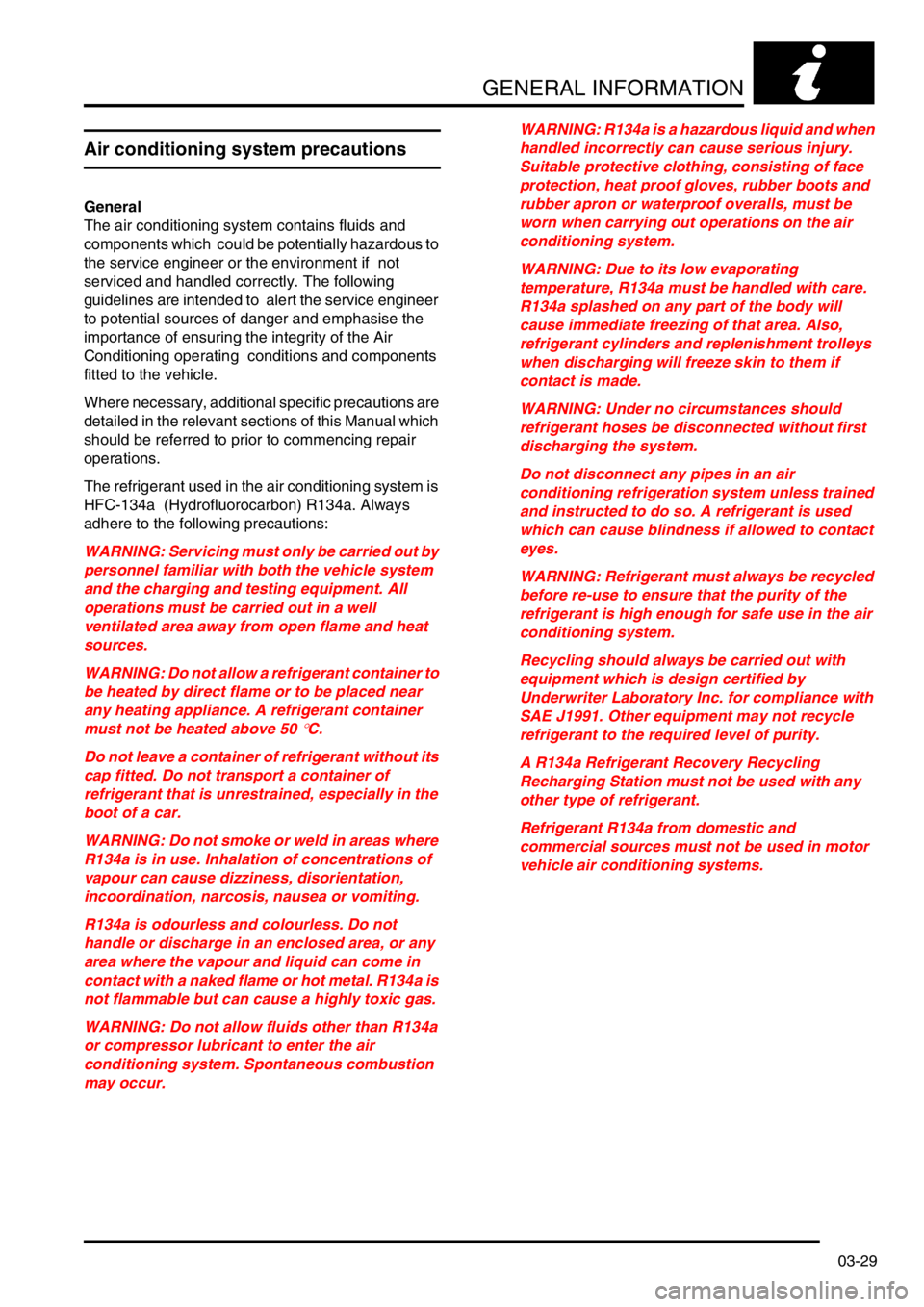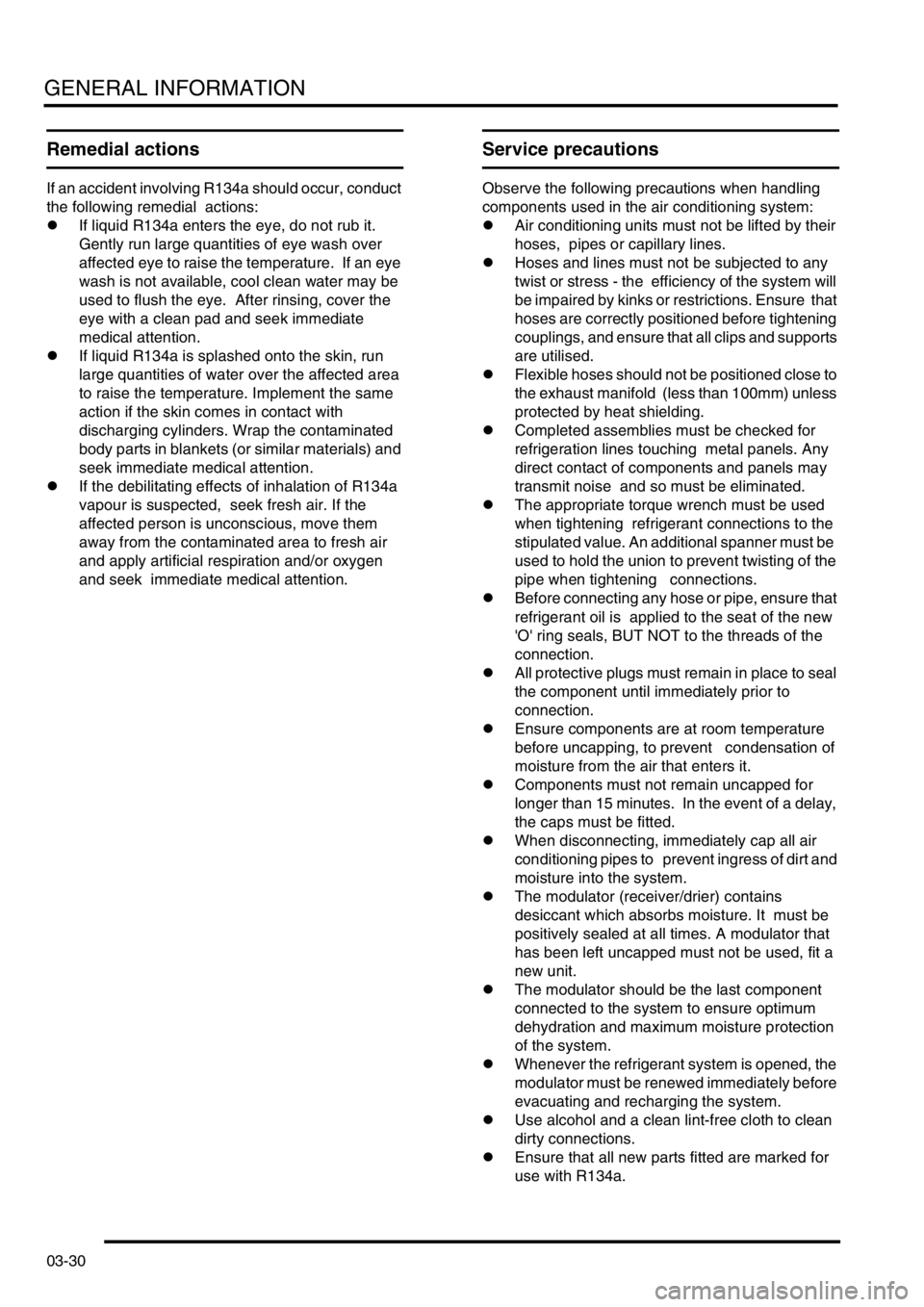air conditioning LAND ROVER FREELANDER 2001 Workshop Manual
[x] Cancel search | Manufacturer: LAND ROVER, Model Year: 2001, Model line: FREELANDER, Model: LAND ROVER FREELANDER 2001Pages: 1007, PDF Size: 23.47 MB
Page 4 of 1007

CONTENTS
CONTENTS 1
INTRODUCTION ...................................................................................... 01-1
How To Use This Manual................................................................................................................ 01-1
Repairs and Replacements ............................................................................................................. 01-2
Specifications .................................................................................................................................. 01-2
Abbreviations and Symbols ............................................................................................................ 01-3
GENERAL INFORMATION ...................................................................... 03-1
General precautions ........................................................................................................................ 03-1
Safety instructions ........................................................................................................................... 03-2
Environmental Precautions ............................................................................................................. 03-3
General fitting instructions .............................................................................................................. 03-7
Ball and roller bearings ................................................................................................................... 03-8
Oil seals .......................................................................................................................................... 03-9
Joints and joint faces ...................................................................................................................... 03-10
Locking devices .............................................................................................................................. 03-10
Screw threads ................................................................................................................................. 03-11
Bolt identification ............................................................................................................................. 03-12
Nut identification ............................................................................................................................. 03-13
Flexible pipes and hoses ................................................................................................................ 03-14
Service tools ................................................................................................................................... 03-16
Rolling road testing ......................................................................................................................... 03-17
Fuel handling precautions ............................................................................................................... 03-18
Electrical precautions ...................................................................................................................... 03-19
Supplementary restraint system precautions .................................................................................. 03-20
SRS component manual deployment ............................................................................................. 03-27
SRS component replacement policy ............................................................................................... 03-28
Air conditioning system precautions ............................................................................................... 03-29
Remedial actions ............................................................................................................................ 03-30
Service precautions ........................................................................................................................ 03-30
Air conditioning compressor replacement ....................................................................................... 03-31
Page 5 of 1007

CONTENTS
2CONTENTS
GENERAL DATA ..................................................................................... 04-1
Engine - Td4 Diesel ........................................................................................................................ 04-1
Engine - K1.8 Petrol........................................................................................................................ 04-6
Engine - KV6 Petrol ........................................................................................................................ 04-11
Fuel system - Td4 Diesel ................................................................................................................ 04-16
Fuel system - K1.8 Petrol ............................................................................................................... 04-18
Fuel system - KV6 Petrol ................................................................................................................ 04-18
Cooling system - Td4 Diesel ........................................................................................................... 04-19
Cooling system - K1.8 Petrol .......................................................................................................... 04-19
Cooling system - KV6 Petrol ........................................................................................................... 04-19
Clutch.............................................................................................................................................. 04-20
Manual Gearbox - Getrag ............................................................................................................... 04-21
Manual Gearbox - PG1 ................................................................................................................... 04-22
Intermediate Reduction Drive (IRD)................................................................................................ 04-24
Automatic Gearbox - Jatco ............................................................................................................. 04-25
Rear Axle and Final Drive ............................................................................................................... 04-26
Steering .......................................................................................................................................... 04-27
Front Suspension............................................................................................................................ 04-28
Rear Suspension ............................................................................................................................ 04-30
Brakes............................................................................................................................................. 04-31
Wheels and tyres ............................................................................................................................ 04-32
Tyre pressures ................................................................................................................................ 04-32
Heating and Ventilation................................................................................................................... 04-33
Air Conditioning .............................................................................................................................. 04-33
Electrical - Td4 engine .................................................................................................................... 04-34
Electrical - K1.8 engine ................................................................................................................... 04-34
Electrical - KV6 engine ................................................................................................................... 04-34
Dimensions ..................................................................................................................................... 04-35
Weights ........................................................................................................................................... 04-36
IDENTIFICATION NUMBERS .................................................................. 05-1
Vehicle Identification Number ......................................................................................................... 05-1
Identification Number Locations ..................................................................................................... 05-2
Page 6 of 1007

CONTENTS
CONTENTS 3
TORQUE WRENCH SETTINGS .............................................................. 06-1
Maintenance ................................................................................................................................... 06-1
Engine – Td4................................................................................................................................... 06-2
Engine – K1.8 ................................................................................................................................. 06-4
Engine – KV6 .................................................................................................................................. 06-6
Emission Control ............................................................................................................................. 06-8
Engine Management System – EDC .............................................................................................. 06-9
Engine Management System – MEMS ........................................................................................... 06-10
Engine Management System – Siemens ........................................................................................ 06-11
Fuel Delivery System – Diesel ........................................................................................................ 06-12
Fuel delivery system – Petrol .......................................................................................................... 06-13
Cooling System – Td4..................................................................................................................... 06-14
Cooling System – K1.8 ................................................................................................................... 06-14
Cooling System – KV6 .................................................................................................................... 06-14
Manifolds and Exhaust System – Td4 ............................................................................................ 06-15
Manifolds and Exhaust Systems – K1.8 ......................................................................................... 06-16
Manifolds and Exhaust Systems – KV6 .......................................................................................... 06-17
Clutch .............................................................................................................................................. 06-18
Manual Gearbox – PG1 .................................................................................................................. 06-19
Manual Gearbox – Getrag .............................................................................................................. 06-20
Intermediate Reduction Drive ......................................................................................................... 06-21
Automatic Gearbox – Jatco ............................................................................................................. 06-22
Driveshafts ...................................................................................................................................... 06-23
Rear Axles and Final Drive ............................................................................................................. 06-24
Steering........................................................................................................................................... 06-25
Front Suspension and Subframe .................................................................................................... 06-26
Rear Suspension and Subframe ..................................................................................................... 06-27
Brakes ............................................................................................................................................. 06-28
Supplementary Restraint Systems .................................................................................................. 06-29
Body ................................................................................................................................................ 06-30
Heating and Ventilation ................................................................................................................... 06-32
Air Conditioning............................................................................................................................... 06-33
Wipers and Washers ....................................................................................................................... 06-34
Electrical ......................................................................................................................................... 06-35
LIFTING AND TOWING ........................................................................... 08-1
Jacking ............................................................................................................................................ 08-1
Towing ............................................................................................................................................ 08-2
Emergency starting ......................................................................................................................... 08-4
CAPACITIES, FLUIDS, LUBRICANTS AND SEALANTS ...................... 09-1
Capacities ....................................................................................................................................... 09-1
Fluids .............................................................................................................................................. 09-2
Lubrication ...................................................................................................................................... 09-3
Sealants .......................................................................................................................................... 09-4
Page 21 of 1007

CONTENTS
18 CONTENTS
HEATING AND VENTILATION ................................................................. 80-1
REPAIRS
Controls - heater - up to 04MY ....................................................................................................... 80-1
Controls - heater - from 04MY ........................................................................................................ 80-2
Servo - air recirculation .................................................................................................................. 80-3
Switch - recirculation control .......................................................................................................... 80-3
Switch - fan - front heater .............................................................................................................. 80-4
Ventilator - face level - LH ............................................................................................................. 80-5
Plenum - air intake ......................................................................................................................... 80-6
Heater unit ..................................................................................................................................... 80-7
Element - positive temperature co-efficient (PTC) heater - Td4 models......................................... 80-10
Harness - positive temperature co-efficient (PTC) heater - Td4 models ........................................ 80-11
Microswitch - positive temperature co-efficient (PTC) heater - Td4 models ................................... 80-14
Blower assembly ............................................................................................................................ 80-14
Resistor unit - fan motor ................................................................................................................ 80-15
Matrix - heater................................................................................................................................. 80-15
Relay - power - positive temperature co-efficient (PTC) - Td4 models ........................................... 80-16
Relay - control - positive temperature co-efficient (PTC) - Td4 models .......................................... 80-17
Fuel burning heater (FBH) .............................................................................................................. 80-18
Sensor - outside temperature (OT) ................................................................................................. 80-19
Fuel pump - fuel burning heater - up to 03MY ................................................................................ 80-20
Fuel pump - fuel burning heater - from 03MY ................................................................................. 80-21
AIR CONDITIONING ................................................................................. 82-1
REFRIGERANT RECOVERY, RECYCLING AND RECHARGING
Refrigerant recovery - recycling and recharge................................................................................ 82-1
ADJUSTMENTS
Drive belt - compressor - Td4 ......................................................................................................... 82-3
REPAIRS
Drive belt - compressor - Td4 ......................................................................................................... 82-5
Compressor - Td4 ........................................................................................................................... 82-6
Compressor - KV6 .......................................................................................................................... 82-7
Compressor - K1.8.......................................................................................................................... 82-8
Condenser ...................................................................................................................................... 82-10
Receiver drier ................................................................................................................................. 82-12
Switch - control ............................................................................................................................... 82-13
Sensor - refrigerant pressure .......................................................................................................... 82-14
Valve - thermostatic expansion (TXV) ............................................................................................ 82-15
Evaporator ..................................................................................................................................... 82-16
Page 28 of 1007

INTRODUCTION
01-3
Abbreviations and Symbols
A Amperes
AAP Ambient Air Pressure
AAT Ambient Air Temperature
ABDC After Bottom Dead Centre
ABS Anti-Lock Brake System
ABS / TC Anti-lock Brake System / Traction
Control
ac Alternating current
A/C Air Conditioning
ACE Active Cornering Enhancement
ACEA Association of Constructors of
European Automobiles
AFR Air Fuel Ratio
AP Ambient Pressure
ASC Anti-shunt Control
ATC Air Temperature Control
ATDC After Top Dead Centre
AUX Auxiliary
AVC Automatic Volume Control
BBDC Before Bottom Dead Centre
BBUS Battery Backed Up Sounder
BCU Body Control Unit
BDC Bottom Dead Centre
bhp Brake Horse Power
BP Boost Pressure
BPP Brake Pedal Position
BS British Standard
BTDC Before Top Dead Centre
BWD Backward
C Celsius
CAN Controller Area Network
CD Compact Disc
CDC Centre Differential Control
CDL Central Door Locking
CD - ROM Compact Disc - Read Only
Memory
CFC Chlorofluorocarbon
CHMSL Centre High Mounted Stop Lamp
CKP Crankshaft Position
CLV Calculated Load Value
cm Centimetre
cm
2Square centimetre
cm3Cubic centimetre
CMP Camshaft Position
CPP Clutch Pedal Position
CO Carbon Monoxide
CO
2Carbon Dioxide
COB Clear Over Base
CR Common Rail
CVS Canister Vent Solenoid
dB Decibels
DDM Driver's Door Module
deg. Degree, angle or temperature
DI Direct Injection
dia. DiameterDIN Deutsche Industrie Normen
(German Industrial Standards)
dc Direct current
DCV Directional Control Valve
DOHC Double Overhead Camshaft
DSP Digital Signal Processing
DTI Dial Test Indicator
DMF Dual Mass Flywheel
DVD Digital Versatile Disc
EACV Electronic Air Control Valve
EAT Electronic Automatic
Transmission
EBD Electronic Brake pressure
Distribution
ECD European Community Directive
ECM Engine Control Module
ECT Engine Coolant Temperature
ECU Electronic Control Unit
EDC Electronic Diesel Control
EEPROM Electronic Erasable
Programmable Read Only
Memory
EGR Exhaust Gas Recirculation
EKA Emergency Key Access
ELR Emergency Locking Retractor
EN European Norm
EOBD European On Board Diagnostics
EON Enhanced Other Network
ERL Electrical Reference Library
ETC Electronic Traction Control
EUI Electronic Unit Injector
EVAP Evaporative Emission
EVR Electronic Vacuum Regulator
F Fahrenheit
ft. Feet
FBH Fuel Burning Heater
FET Field Effect Transistor
FIP Fuel Injection Pump
FTC Fast Throttle Control
FWD Forward
> Greater than
g Gramme or Gravity
gal. Gallons
GMT Greenwich Mean Time
GPS Global Positioning System
hHour
hc High compression
HC Hydro Carbons
HDC Hill Descent Control
HDOP Height Dilation Of Precision
HDPE High Density Polyethylene
HFS Heated Front Screen
Hg Mercury
HO
2S Heated Oxygen Sensor
HMW High Molecular Weight
Page 34 of 1007

GENERAL INFORMATION
03-3
Brake hydraulics
Observe the following recommendations when
working on the brake system:
lAlways use two spanners when loosening or
tightening brake pipe or hose connections.
lEnsure that hoses run in a natural curve and are
not kinked or twisted.
lFit brake pipes securely in their retaining clips
and ensure that the pipe run cannot contact a
potential chafing point.
lContainers used for hydraulic brake fluid must
be kept absolutely clean.
lDo not store hydraulic brake fluid in an unsealed
container, it will absorb water and in this
condition would be dangerous to use due to a
lowering of its boiling point.
lDo not allow hydraulic brake fluid to be
contaminated with mineral oil, or put new
hydraulic brake fluid in a container which has
previously contained mineral oil.
lDo not re-use hydraulic brake fluid previously
removed from the system.
lAlways use clean brake fluid or a recommended
alternative to clean hydraulic components.
lFit a blanking cap to a hydraulic union and a
plug to its socket, immediately after
disconnection of pipes and hoses to prevent the
ingress of dirt.
lAbsolute cleanliness must be observed when
working with hydraulic components.
lIt is imperative that the correct brake fittings are
used and that threads of components are
compatible.
Cooling system caps and plugs
Extreme care is necessary when removing engine
cooling system expansion tank caps and coolant
drain or bleed screws when the engine is hot, and
especially if it is overheated.
To avoid the possibility of scalding allow the engine
to cool before attempting coolant cap or plug
removal.
Environmental Precautions
General
This section provides general information which can
help to reduce adverse environmental impacts
incurred through the activities carried out in
workshops.
Emissions to air
Many of the activities that are carried out in
workshops emit gases and fumes which contribute to
global warming, depletion of the ozone layer and/or
the formation of photo-chemical smog at ground
level. By considering and controlling how the
workshop activities are carried out, these gases and
fumes can be minimised, thus reducing the damage
to the environment.
Exhaust fumes
Running car engines is an essential part of workshop
activities and exhaust fumes need to be ventilated to
atmosphere. However, the amount of time engines
are running and the position of the vehicle should be
carefully considered at all times, to reduce the
release of poisonous gases and minimise the
inconvenience to people living nearby.
Solvents
Some of the cleaning agents used are solvent based
and will evaporate to atmosphere if used carelessly,
or if cans are left unsealed. All solvent containers
should be firmly closed when not needed and solvent
should be used sparingly. Suitable alternative
materials may be available to replace some of the
commonly used solvents. Similarly, many paints are
solvent based and the spray should be minimised to
reduce solvent emissions.
Refrigerant
It is illegal to release any refrigerants into the
atmosphere. Discharge and replacement of these
materials from air conditioning units should only be
carried out using the correct equipment.
Checklist
Always adhere to the following:
Engines –
ldon't leave engines running unnecessarily;
lminimise testing times and check where the
exhaust fumes are being blown.
Page 45 of 1007

GENERAL INFORMATION
03-14
Self-locking nuts
Self-locking nuts, i.e. nylon insert or deferred thread
nuts can be re-used providing resistance can be felt
when the locking portion of the nut passes over the
thread of the bolt or stud.
DO NOT apply heat in an attempt to free deferred
thread nuts or fittings; as well as causing damage to
protective coatings, there is a risk of damage to
electronic equipment and brake linings from stray
heat.
Where self-locking nuts have been removed, it is
advisable to replace them with new ones of the same
type.
Where bearing pre-load is involved, nuts should be
tightened in accordance with special instructions.
Flexible pipes and hoses
General
When removing and installing flexible hydraulic pipes
and hoses, ensure that the following practices are
observed to ensure component serviceability:
lBefore removing any brake or power steering
hose, clean end fittings and area surrounding
them as thoroughly as possible.
lObtain appropriate plugs or caps before
detaching hose end fittings, so that the ports
can be immediately covered to prevent the
ingress of dirt.
lClean hose externally and blow through with
airline. Examine carefully for cracks, separation
of plies, security of end fittings and external
damage. Reject any faulty hoses.
lWhen refitting a hose, ensure that no
unnecessary bends are introduced, and that
hose is not twisted before or during tightening of
union nuts.
lFit a cap to seal a hydraulic union and a plug to
its socket after removal to prevent ingress of
dirt.
lAbsolute cleanliness must be observed with
hydraulic components at all times.
lAfter any work on hydraulic systems, carefully
inspect for leaks underneath the vehicle while a
second operator applies maximum brake
pressure to the brakes (engine running) and
operates the steering.
Do not disconnect any pipes in an air
conditioning refrigeration system unless trained
and instructed to do so. A refrigerant is used
which can cause blindness if allowed to contact
eyes.
Page 60 of 1007

GENERAL INFORMATION
03-29
Air conditioning system precautions
General
The air conditioning system contains fluids and
components which could be potentially hazardous to
the service engineer or the environment if not
serviced and handled correctly. The following
guidelines are intended to alert the service engineer
to potential sources of danger and emphasise the
importance of ensuring the integrity of the Air
Conditioning operating conditions and components
fitted to the vehicle.
Where necessary, additional specific precautions are
detailed in the relevant sections of this Manual which
should be referred to prior to commencing repair
operations.
The refrigerant used in the air conditioning system is
HFC-134a (Hydrofluorocarbon) R134a. Always
adhere to the following precautions:
WARNING: Servicing must only be carried out by
personnel familiar with both the vehicle system
and the charging and testing equipment. All
operations must be carried out in a well
ventilated area away from open flame and heat
sources.
WARNING: Do not allow a refrigerant container to
be heated by direct flame or to be placed near
any heating appliance. A refrigerant container
must not be heated above 50
°C.
Do not leave a container of refrigerant without its
cap fitted. Do not transport a container of
refrigerant that is unrestrained, especially in the
boot of a car.
WARNING: Do not smoke or weld in areas where
R134a is in use. Inhalation of concentrations of
vapour can cause dizziness, disorientation,
incoordination, narcosis, nausea or vomiting.
R134a is odourless and colourless. Do not
handle or discharge in an enclosed area, or any
area where the vapour and liquid can come in
contact with a naked flame or hot metal. R134a is
not flammable but can cause a highly toxic gas.
WARNING: Do not allow fluids other than R134a
or compressor lubricant to enter the air
conditioning system. Spontaneous combustion
may occur.WARNING: R134a is a hazardous liquid and when
handled incorrectly can cause serious injury.
Suitable protective clothing, consisting of face
protection, heat proof gloves, rubber boots and
rubber apron or waterproof overalls, must be
worn when carrying out operations on the air
conditioning system.
WARNING: Due to its low evaporating
temperature, R134a must be handled with care.
R134a splashed on any part of the body will
cause immediate freezing of that area. Also,
refrigerant cylinders and replenishment trolleys
when discharging will freeze skin to them if
contact is made.
WARNING: Under no circumstances should
refrigerant hoses be disconnected without first
discharging the system.
Do not disconnect any pipes in an air
conditioning refrigeration system unless trained
and instructed to do so. A refrigerant is used
which can cause blindness if allowed to contact
eyes.
WARNING: Refrigerant must always be recycled
before re-use to ensure that the purity of the
refrigerant is high enough for safe use in the air
conditioning system.
Recycling should always be carried out with
equipment which is design certified by
Underwriter Laboratory Inc. for compliance with
SAE J1991. Other equipment may not recycle
refrigerant to the required level of purity.
A R134a Refrigerant Recovery Recycling
Recharging Station must not be used with any
other type of refrigerant.
Refrigerant R134a from domestic and
commercial sources must not be used in motor
vehicle air conditioning systems.
Page 61 of 1007

GENERAL INFORMATION
03-30
Remedial actions
If an accident involving R134a should occur, conduct
the following remedial actions:
lIf liquid R134a enters the eye, do not rub it.
Gently run large quantities of eye wash over
affected eye to raise the temperature. If an eye
wash is not available, cool clean water may be
used to flush the eye. After rinsing, cover the
eye with a clean pad and seek immediate
medical attention.
lIf liquid R134a is splashed onto the skin, run
large quantities of water over the affected area
to raise the temperature. Implement the same
action if the skin comes in contact with
discharging cylinders. Wrap the contaminated
body parts in blankets (or similar materials) and
seek immediate medical attention.
lIf the debilitating effects of inhalation of R134a
vapour is suspected, seek fresh air. If the
affected person is unconscious, move them
away from the contaminated area to fresh air
and apply artificial respiration and/or oxygen
and seek immediate medical attention.
Service precautions
Observe the following precautions when handling
components used in the air conditioning system:
lAir conditioning units must not be lifted by their
hoses, pipes or capillary lines.
lHoses and lines must not be subjected to any
twist or stress - the efficiency of the system will
be impaired by kinks or restrictions. Ensure that
hoses are correctly positioned before tightening
couplings, and ensure that all clips and supports
are utilised.
lFlexible hoses should not be positioned close to
the exhaust manifold (less than 100mm) unless
protected by heat shielding.
lCompleted assemblies must be checked for
refrigeration lines touching metal panels. Any
direct contact of components and panels may
transmit noise and so must be eliminated.
lThe appropriate torque wrench must be used
when tightening refrigerant connections to the
stipulated value. An additional spanner must be
used to hold the union to prevent twisting of the
pipe when tightening connections.
lBefore connecting any hose or pipe, ensure that
refrigerant oil is applied to the seat of the new
'O' ring seals, BUT NOT to the threads of the
connection.
lAll protective plugs must remain in place to seal
the component until immediately prior to
connection.
lEnsure components are at room temperature
before uncapping, to prevent condensation of
moisture from the air that enters it.
lComponents must not remain uncapped for
longer than 15 minutes. In the event of a delay,
the caps must be fitted.
lWhen disconnecting, immediately cap all air
conditioning pipes to prevent ingress of dirt and
moisture into the system.
lThe modulator (receiver/drier) contains
desiccant which absorbs moisture. It must be
positively sealed at all times. A modulator that
has been left uncapped must not be used, fit a
new unit.
lThe modulator should be the last component
connected to the system to ensure optimum
dehydration and maximum moisture protection
of the system.
lWhenever the refrigerant system is opened, the
modulator must be renewed immediately before
evacuating and recharging the system.
lUse alcohol and a clean lint-free cloth to clean
dirty connections.
lEnsure that all new parts fitted are marked for
use with R134a.
Page 62 of 1007

GENERAL INFORMATION
03-31
When a major repair has been completed, a leak test
should be conducted; refer to the air conditioning
section of this manual for the correct procedure.
Refrigerant oil
Use an approved refrigerant lubricating oil:
ND Oil 8
CAUTION: Do not use any other type of
refrigerant oil.
CAUTION: Refrigerant oil easily absorbs water
and must not be stored for long periods. Do not
pour unused oil back into the container.
When renewing system components, add the
quantities of refrigerant oil recommended in the Air
Conditioning section of this manual.
Compressor
A new compressor is sealed and pressurised with
Nitrogen gas. When fitting a new compressor, slowly
release the sealing cap; gas pressure should be
heard to vent as the seal is broken.
CAUTION: A new compressor should always be
sealed and could be pressurised with nitrogen
gas. To avoid possible oil loss, release the
sealing cap(s) slowly. Do not remove the cap(s)
until immediately prior to connecting the air
conditioning pipes to the compressor.
Rapid refrigerant discharge
If the air conditioning system is involved in accident
damage and the system is punctured, the refrigerant
will discharge rapidly. The rapid discharge of
refrigerant will also result in the loss of most of the
oil from the system. The compressor must be
removed and all the remaining oil in the compressor
drained and refilled in accordance with the 'Air
Conditioning Compressor Replacement Procedure'.
Air conditioning compressor
replacement
A new compressor is supplied filled with a full charge
of (X cm3) of refrigerant oil.
A new compressor is supplied with an oil fill (X cm) of
120 cm
3.
A calculated quantity of oil must be drained from the
new compressor before fitting. To calculate the
quantity of oil to be drained:
1Remove the drain plug from the old
compressor.
2Invert the compressor and gravity drain the oil
into a calibrated measuring cylinder. Rotate the
compressor clutch to ensure the compressor is
completely drained.
3Note the quantity of oil drained (Y cm
3).
4Calculate the quantity of oil to be drained from
the new compressor using the following
formula:
X cm
3 – (Y cm3 + 20 cm3) = Q cm3
5Remove the drain plug from the new
compressor and drain Q cm3 of oil.
6Fit and tighten the compressor drain plug.
System components
When renewing system components, add the
following quantities of refrigerant oil:
lCondenser = 40 cm
3
lEvaporator = 30 cm 3
lReceiver drier = 15 cm 3
lPipe or hose = 5 cm 3